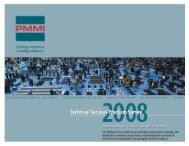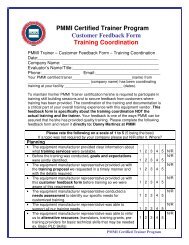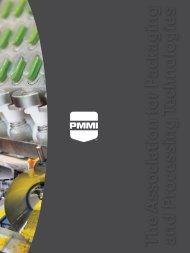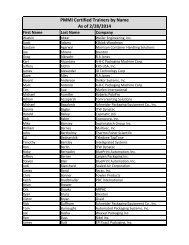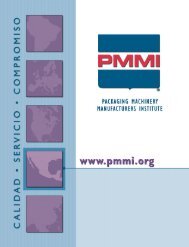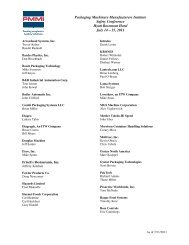Canadian Packaging Machinery Market Research Report - PMMI
Canadian Packaging Machinery Market Research Report - PMMI
Canadian Packaging Machinery Market Research Report - PMMI
Create successful ePaper yourself
Turn your PDF publications into a flip-book with our unique Google optimized e-Paper software.
4.0 THE BEVERAGE INDUSTRY<br />
4.1 INDUSTRY OVERVIEW<br />
In 2001, the last year for which complete industry data is available, beverage industry<br />
production reached $C9.5 billion, a 0.07 per cent increase over 2000. Beverage<br />
industry shipments accounted for approximately 1.8 percent of the value of Canada’s<br />
total manufacturing shipments. In 2001, Canada’s beverage manufacturing industry<br />
was comprised of 563 establishments that employed approximately 30,000 people. It<br />
should be noted that, for the purposes of this report, the traditional definition of the<br />
beverage industry has been expanded to include bottled water, juice, and tea and<br />
coffee manufacturers.<br />
Data from the Brewers Association of Canada indicate that per capita consumption of<br />
beer, spirits, and wine was 105.54 litres in 2002, a 1.78 percent increase over 2001.<br />
The per capita consumption calculation is based on the adult population 15 years<br />
and older. Of the 2002 total, per capita beer consumption was 86.06 litres, a 1.27<br />
percent increase over 2001, per capita spirits consumption was 6.51 litres, a 0.4<br />
percent increase over 2001, and per capita wine consumption was 12.97 litres, a<br />
3.35 per cent increase over 2001. The increase in per capita spirits consumption can<br />
be attributed to an increase in the sale of spirit based coolers, which represent 32.5<br />
percent of total spirit sales in Canada.<br />
Almost one-half of <strong>Canadian</strong> beer is brewed in Ontario, slightly more than onequarter<br />
is brewed in Quebec, and almost 20 percent is brewed in the Western<br />
provinces. The most popular packaging format for domestically brewed beer is<br />
bottles. Beer sold in bottles accounted for 68.1 percent of the domestic beer market<br />
in 2002, a 1.73 percent decrease from 2001, and beer sold in cans accounted for<br />
21.1 percent of the market in 2002, an 8.21 percent increase over the prior year.<br />
Beer sold as draught accounted for 10.8 percent of the market in 2002, a 3.57<br />
percent decrease from 2001.<br />
The majority of the distillery industry is located in Ontario where more than 60<br />
percent of spirits are distilled. The majority of Canada’s wine industry is located in<br />
British Columbia and Ontario, as these two provinces produce 98 percent of<br />
Canada’s premium wine volume.<br />
Canada’s alcoholic beverage manufacturers, for the most part, supply the domestic<br />
market, where 82.5 percent of their output is shipped. The remainder is exported.<br />
Almost 45 percent of total alcoholic beverage exports are composed of one<br />
commodity: whiskies. Ninety percent of <strong>Canadian</strong> whisky exports go to the United<br />
States.<br />
The bottled water industry is a small but rapidly growing sub-sector of the beverage<br />
industry as many <strong>Canadian</strong>s drink bottled water on a regular basis. The majority of<br />
the bottling plants are located in the provinces of Quebec, Ontario and British<br />
Columbia. In 2001, according to statistics published in the March/April 2002 issue of<br />
Western Grocer Magazine, per capita consumption of bottled water in Canada was<br />
SMG/Columbia Consulting Group Page 133



